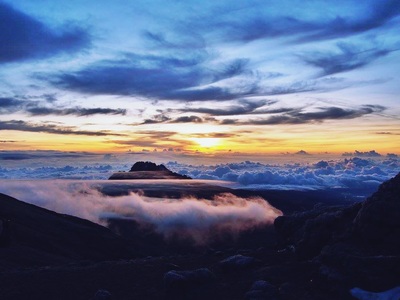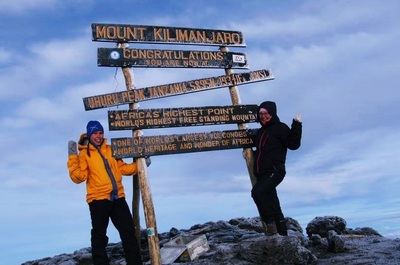Kilimanjaro
The highest mountain in Africa, Kilimanjaro (5 892 meters, 19 334 feet), is located in northern Tanzania. Kilimanjaro is also the highest freestanding mountain in the world. Next to the equator, this dormant volcano is a wonder to behold. Its multi-faceted ecosystem and cultural history make it a destination that is not to be missed.
Kilimanjaro National Park (756km2) was founded 1973 and it is listed by UNESCO as one of the World Heritage Sites. Kilimanjaro National Park includes the bottom slopes of the mountain as 1800 meters to the crater at the top of the mountain. There are four different climate and vegetation zones in this park: rain forests, moors, alpine highlands and the Glacier Peak.
Regardless of the climate change and global warming effects it's still snowing at the top of Mt. Kilimanjaro. Almost every healthy and fit person can conquer the top of mountain. However, the climb becomes more difficult as you ascend, due to the lack of oxygen. There is only 40 percent of the oxygen that you would find at sea level. Marangu is the most popular route to the top of Kilimanjaro and 65 percent of climbers use this route. Trekking to the top takes a minimum of 5 days, with a higher success of reaching the top if you increase the number of days you take to climb.
Tanzania Volunteers is organizing climbing on all the routes. Here you can see couple of examples of the route options and time tables:
Kilimanjaro National Park (756km2) was founded 1973 and it is listed by UNESCO as one of the World Heritage Sites. Kilimanjaro National Park includes the bottom slopes of the mountain as 1800 meters to the crater at the top of the mountain. There are four different climate and vegetation zones in this park: rain forests, moors, alpine highlands and the Glacier Peak.
Regardless of the climate change and global warming effects it's still snowing at the top of Mt. Kilimanjaro. Almost every healthy and fit person can conquer the top of mountain. However, the climb becomes more difficult as you ascend, due to the lack of oxygen. There is only 40 percent of the oxygen that you would find at sea level. Marangu is the most popular route to the top of Kilimanjaro and 65 percent of climbers use this route. Trekking to the top takes a minimum of 5 days, with a higher success of reaching the top if you increase the number of days you take to climb.
Tanzania Volunteers is organizing climbing on all the routes. Here you can see couple of examples of the route options and time tables:
|
MARANGU ROUTE 6 DAYS
Marangu route is the most popular of all the different Kilimanjaro hiking routes. It is possible to climb it on 5 days but it is not recommended since the acclimatization time becomes too short. Part of the Marangu Route’s success is the accommodation in huts. Porters will carry all your equipments and cook will prepare all the foods. You will only carry your own one day rucksack. The total length of the hiking is about 96 kilometers. DAY 1 MARANGU GATE (1980 M) – MANDARA HUT (2700 M) HIKING TIME 5 HOURS DISTANCE ABOUT 12 KM The trip begins from Moshi. Driving to Marangu gate takes about 50 minutes. At the gate you make sure that you have everything that you need during the day; clothes, lunchbox and drinking water. Rest of your equipments you leave to the porters who hike to the first hut much faster than you. From the gate you start hiking through the rainforest with the guides. The first night you spend in Mandara Hut where there are wooden A-style huts. Every hut can accommodate 6 to 8 hikers. The huts have lights which work by solar energy. Altogether the hut village can accommodate up to 60 hikers. There is spring water available in Mandara. DAY 2 MANDARA HUT (2700 M)- HOROMBO HUT (3720 M) HIKING TIME 6 HOURS DISTANCE ABOUT 15 KM From Mandara Hut you first climb through short forest area to Maundi crater. There the mountain forest changes to moorland. If you climb Maundi crater you will see the first amazing views to Kilimanjaro peak, Kibo crater. In the open moorland you will see the amazing flora of Kilimanjaro eg gigantic lobelia which can grow over 3 meters high. After 6 hours of hiking you will arrive to Horombo Hut where you will get a chance to wash with warm water, rest, eat your dinner and sleep until next morning. DAY 3 HOROMBO HUT (3720 M- ACCLIMATISATION DAY) ON 5 DAYS CLIMBING YOU DON’T HAVE THIS EXTRA DAY IN HOROMBO Horombo Hut is a hut village built on plateau. The village can accommodate up to 120 climbers. The huts are similar to Mandara. In the village you can see climbers, guides and porters going up and down. In Horombo Hut you can spend one extra day and night to get used to the thin mountain air. To help the acclimatization you will do a short day hiking towards Mawenzi Hut. Hiking takes about 3 hours up and 1,5 hours back. During the day it is good to drink a lot and move slowly so that your body can recover from previous hiking and get used to the thin air. DAY 4 HOROMBO HUT (3720 M)- KIBO HUT (4700 M) HIKING TIME ABOUT 6 HOURS DISTANCE 15 KM After the breakfast you continue the hiking to alpine desert. The route goes from Horombo Hut to the “Saddle” desert between peaks Mawenzi and Kibo. It is very important to walk slowly and drink a lot of water. Kibo Hut is a stone hut built to an open alpine desert. It can accommodate up to 60 climbers. Notice that there is no running water in this hut. The final peak is 1195 meters up from this hut and you will make the final climbing still at the same night. So go to sleep early, latest at 7pm and try to rest as much as you can. DAY 5 KIBO HUT (4700 M)- UHURU PEAK (5895 M) HIKING TIME ABOUT 8 HOURS TO UHURU AND RETURNING TO HOROMBO 6 HOURS DISTANCE 6 KM UP AND 21 KM DOWN You will wake up at 23.30. After a cup of tea and some biscuits you start your climbing up to the peak at midnight. This is the most difficult part of the climbing. The first stage is a rocky path up to Hans Meyer cave (5150m) where you can rest a little bit. From there the path continues as zigzag to the Gillmanns point (5681m). This part is very steep and rocky and it requires very good physical and mental condition. Exactly this point is the most challenging in the whole climbing. Be patients and move slowly! After Gillmanns point you climb in the snow all the way to the peak. You have now reached Uhuru Peak (5895m), the highest peak in whole Africa! It depends of the weather how much time you can spend on the peak and take photos. After that starts 3 hours returning back to the Kibo Hut. There you can rest a little and gather all your energy and climb other 3 hours down to the Horombo hut where you spend night. Going down is much faster than going up. Still the time that you walk during this day is about 14 hours so prepare yourself well for this day. In the evening you will eat your last meal on the mountain and you can buy beer or soft drinks from the camp’s office. And finally you can go to sleep. DAY 6 HOROMBO HUT (3720 M)- MARANGU GATE (1980 M) HIKING TIME ABOUT 6 HOURS DISTANCE ABOUT 27 KM After the breakfast you continue going down past Mandara Hut all the way to the gate. At the gate you will check that all your equipment's have arrived with the porters. If you managed to reach the peak you will also get a certification. Those who reached Gillmanns point get green one and those who reached Uhuru Peak get golden one. After that you will return to your hotel. |
MACHAME ROUTE 6 DAYS
DAY 1 MACHAME GATE (1800 M) – MACHAME CAMP (3000 M) DISTANCE ABOUT 10 KILOMETRES At 8 o’clock in the morning you will leave from Moshi to Machame gate. On the gate you will meet the porters, guides and cooks. You will also check all your equipments and make sure that you have everything you need during the day in your back bag. After you have registered you are ready to start the hiking. The porters and cooks will always walk ahead you and they will set up the camp ready every day before you arrive. On the first day you will hike in the moss-covered Kilimanjaro forest. By the end of the day the forest will thin and tall grasses will take space. On the clear weather you will be able to see the Kibo peak. DAY 2 MACHAME CAMP (3000 M) – SHIRA CAMP (3840 M) DISTANCE ABOUT 7 KILOMETRES The second day hiking includes several uphill sections. The scenery is very open and there is not much shadow so make sure that you have enough drinking water with you on the second day. It can be really hot! You will pass several viewpoints from where you can see the forest below and Kibo peak above. As you climb higher all the time the trees will get smaller and different high altitude plants will become more. After eating lunch you will climb to Shira Plateau which was formed when lava flows from Kibo filled the Shira crater. DAY 3 SHIRA CAMP (3840 M) - BARRANCO CAMP (3950 M) DISTANCE ABOUT 10 KILOMETRES On the third day you will actually hike up to 4530 meters by the early afternoon but then you will descend quickly to Barranco Camp. This day is very important for then acclimatization. The Barranco Camp is said to be the most scenic on the Machame Route. DAY 4 BARRANCO CAMP (3950 M) – BARAFU CAMP (4600 M) DISTANCE ABOUT 13 KILOMETRES After the breakfast you will have 1 and half hours tough struggle up the Barranco Wall. That will be the hardest part of the day. After you reach the top you will descent a little bit to the green Karanga Valley and then continue by several glaciers. During this day you will have stunning views of Kibo and Mawenzi peaks. Go to sleep as soon as you have eaten your dinner as you will wake up before midnight for your final hiking to the summit. DAY 5 BARAFU CAMP (4600 M) – UHURU PEAK (5895 M) – MWEKA CAMP (3100 M) DISTANCE ABOUT 18 KILOMETRES Around the midnight you will start your last hiking to the summit. The first 6 hours you will hike by the light of your headlight. The climbing to the crater rim is the most difficult part of the whole hike. After the Stella Point the last hike to the peak is not difficult. But you have to remember the altitude that makes everything much more challenging than down here. You have to move very slowly. Once you reach Uhuru take photos of yourself and your friends on the peak and start you way back down. On your way down you will see amazing views. You will eat your breakfast in Barafu Camp and have a short break. But remember that you still need to continue for another three to five hours. DAY 6 MWEKA CAMP (3100 M) – MWEKA GATE (1500 M) DISTANCE ABOUT 10 KILOMETRES On your last day you will just walk down to the Mweka gate. On your way you will see the beautiful Kilimanjaro cloud forest. Once you reach the gate your transportation is waiting there to take you back to your hotel. |



